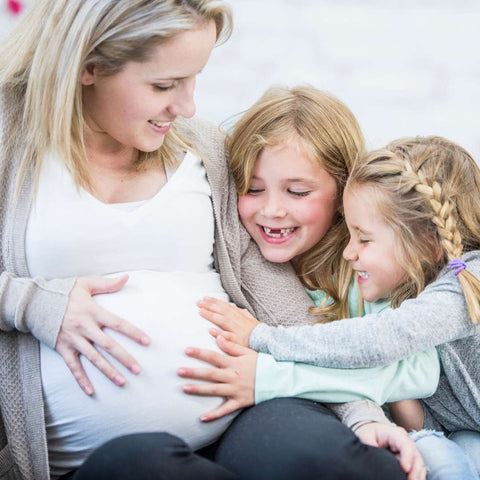The 3rd trimester
3rd trimester of pregnancy - How a mother feels
During this stage of pregnancy, the fetus reaches the crucial maturity of its lungs and continues to grow in size and weight. Mothers find the constant growth of their belly increasingly exhausting. But relief is in sight: with the onset of contractions, the baby moves deeper into the pelvis, creating more space for the diaphragm and stomach.
Contents
- The 3rd trimester: when does it start?
- The 3rd trimester: How your baby develops
- The birth position of babies
- Stargazing babies
- The breech presentation
- What should be done in the event of a breech presentation?
- The last trimester: How is the mother's well-being?
- The 3rd trimester - what mothers eat
- Labor activity in the last trimester of pregnancy
- Useful tips for the last trimester
- Trimester: Frequently asked questions & answers
-------------------------------------

3rd trimester of pregnancy - How a mother feels
1 The 3rd trimester: when does it start?
From the 28th week, you enter the final phase of pregnancy, known as the third trimester or trimester. This phase stretches from the 28th to the 40th week of pregnancy, with the climax at the end of the 40th week: the expected date of birth.
2. the 3rd trimester: how your baby develops
| Week of pregnancy | Your baby's development |
| Week 28 to 33 | The development of the brain, nervous system and most organs is almost complete and they are ready for the start of life |
| Week 33 to 36 | Your baby assumes the position for birth and develops the important lung maturity. |
| SSW 37 to 40 | From now on, your baby is no longer considered premature. Birth can begin at any time from this point onwards. |
For many expectant mothers, entering the last trimester brings a moment of reassurance: if the baby is born now, it is viable. Even if it is born before the 37th week of pregnancy and is therefore considered premature, the chances of a successful start to life are good thanks to medical support.
By the time the 32nd week of pregnancy is reached, your baby's brain, nervous system and organ functions are prepared for life outside your body. Muscles and bones are getting stronger, ready for life after birth. The brain is working hard to develop new neural connections, perfecting reflexes such as grasping and swallowing, as well as the ability to forage for food.
Babies usually assume the birth position by the 35th week of pregnancy. The space in the abdomen becomes narrower, as babies can still grow by 15 to 20 centimeters during this time. If your baby has not yet changed position in the 35th week of pregnancy, there is no need to worry; some babies still turn later.
An important developmental step takes place in the 36th week of pregnancy: the alveoli are mature, which means that your baby will be able to breathe independently after birth. Children born from the 37th week of pregnancy normally no longer require breathing assistance.
In the 40th week of pregnancy, your baby will have reached an average weight of 3440 grams and a height of 51 centimeters. These values can vary from person to person, as the size of the parents, nutrition during pregnancy and genetic factors all play a role.

3. the birth position of babies
By the 36th week of pregnancy, almost 90 percent of all babies have moved into the cephalic position, which means that the baby's head has entered the mother's pelvis. This position creates optimal conditions for a smooth birth process. In the so-called anterior occipital position, the baby's occiput enters the birth canal first, paving the way for the rest of the body. The baby's chin is tilted towards the breast, while the face faces the mother's sacrum.
4. stargazer babies
The term "stargazer" is often used in birth reports. This describes babies who are born head first but face upwards, i.e. towards the ceiling. Born in the posterior occipital position, these babies initially look up at the ceiling - or at the stars if they were born in the open air. Although this position is not problematic per se, it can make the birth more difficult for the mother, as the baby does not make itself as small as it would in other positions. As a result, the birth may take longer. Nevertheless, the position of a "stargazer" is no cause for concern.
5. the breech position
Even a baby in a breech position is generally no cause for concern, although this position is considered less favorable. A baby in the breech position is not born head first, but with its bottom or feet first. This position carries risks, as in rare cases the umbilical cord can become trapped between the baby and the birth canal, which could lead to a lack of oxygen for the baby. In addition, the baby's head is the part of the body with the largest circumference. If the buttocks or feet are born first, the birth canal may not be sufficiently dilated for the head, which can make the birth more difficult.
6 What should be done in the event of a breech presentation?
Doctors often recommend a caesarean section for a breech presentation. However, there are still clinics and birthing centers that have the expertise for vaginal births in breech presentation and support women in this situation. Comprehensive obstetric advice is essential in such cases.
7. the last trimester: how is the mother's well-being?
In the last trimester
For expectant mothers, the last trimester is often the most challenging and exciting phase of pregnancy. Maternity protection comes into force 42 days before the planned date of birth. This means that the expectant mother is released from work and enjoys special protection under labor law. Women with statutory health insurance who are entitled to sick pay receive maternity benefit during this period.
Many women experience various complaints in the final trimester of pregnancy:
- Stomach burning
- Pain in the back area
- Problems sleeping and difficulty falling asleep
- Shortness of breath and a feeling of dizziness
- Increased urge to urinate
- Retention of water in the body



























